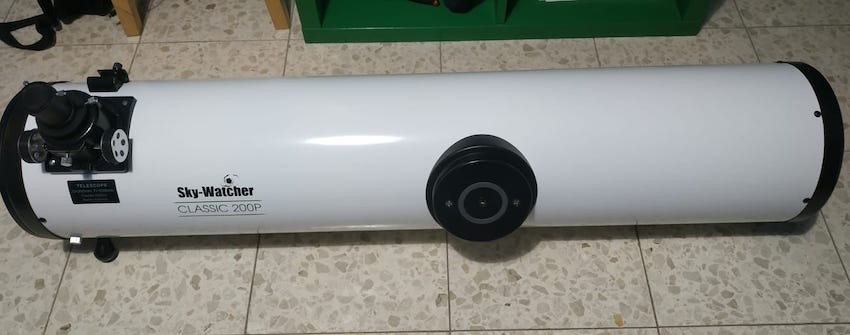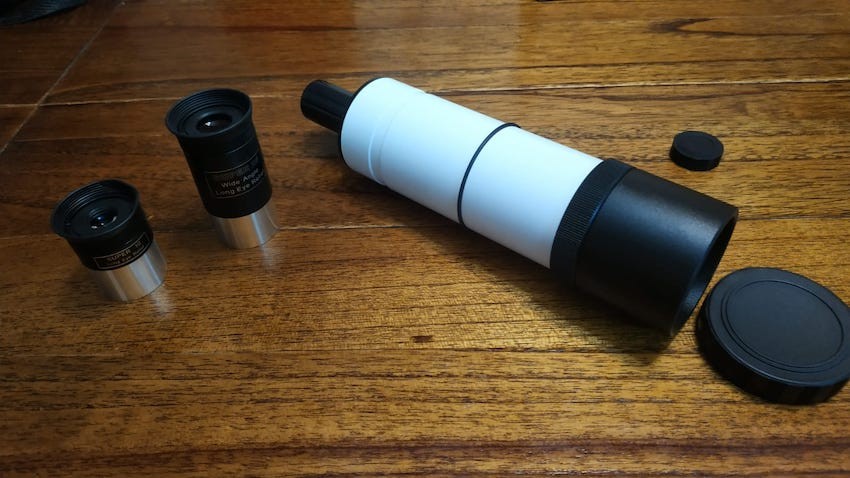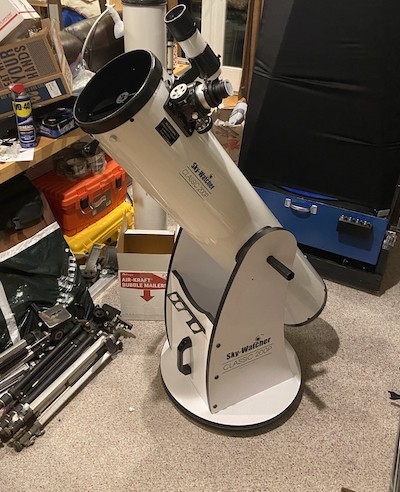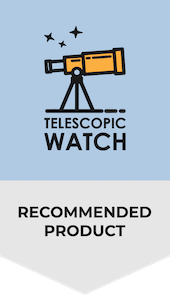The Quality of Optical Tube and Optics

The SkyWatcher 8” Traditional, or the Classic 200P, is an 8” aperture, f/5.9 focal ratio Newtonian reflector, manufactured by China-based Suzhou Synta Optical Technologies—the same company that owns Celestron and used to manufacture Orion’s XT and XX Dobsonians.
The telescope’s mirrors are made of borosilicate glass (Pyrex), which expands far less with temperature changes than the more common plate glass that I’ve seen in many cheaper and even similarly priced telescopes. Quality-wise, the mirrors tend to be good in almost all Classic 200P scopes that I’ve handled.
At f/5.9 focal ratio, there isn’t any coma like there is with faster focal ratio scopes such as Sky-Watcher’s own 10” and larger models, which have faster focal ratios to avoid being cumbersome and, in the case of the largest size telescopes, requiring a tall ladder.
The Classic 200P’s tube length is identical to SkyWatcher’s own 150P and other manufacturers’ 6” f/8 Dobsonians (for eg. Aperture AD6 which I very much like). As a result, the 200P is not really any more cumbersome to transport or more difficult to store than a typical 6″ dobsonian.
I really like solid tubes for 8ʺ Dobs. A 10ʺ scope becomes a bit uncomfortable to wrap your arms around, and a 12ʺ or larger is a nightmare to handle, unless you are built like Paul Bunyan.
Issues I’ve Had With It’s Rack and Pinion Focuser
The focuser on the Sky-Watcher 8” Dobsonian is a rack-and-pinion. It works just as well as a higher-priced Crayford unit, but there are two issues I have with it.
- First, the knobs are made of hard plastic with little ridges that dig into our fingers.
- Second, the focuser comes with a strange thread-on 1.25” adapter and a thread-on 2” adapter, which means that unless you spend additional money on a separate 1.25” to 2” adapter, you’ll be fumbling around in the dark with these silly adapters. I don’t get why Sky-Watcher elected to add this system rather than just supplying the 2” adapter and a 1.25” to 2” adapter.
The Accessories and My Recommended Aftermarket Buys

The 8” Traditional comes with 25mm (48x magnification) and 10mm (120x magnification) “Super” eyepieces that seemed to be Plossls to me. They work well, as I tested.
But, still, I’d advise you to get additional 6mm and 9mm “gold-line” eyepieces at the minimum for high magnification views (the included 10mm Super was a little short on eye relief when I used it). These high-power eyepieces will provide great close-up views of the Moon, planets, double stars, and globular star clusters.
I’d also recommend a 2” wide-angle eyepiece such as the GSO 30mm SuperView. The wide-angle 2” eyepiece will make it easier to find objects and provide the maximum possible field of view for expansive views of nebulae, star clusters, and other deep-sky objects.
The 8” Traditional comes with a 9x50mm straight-through finderscope. In addition to being uncomfortable to aim through at almost every angle, I don’t like that the finder’s images are inverted.
I’d recommend a Telrad or Rigel Quikfinder as a great supplement or replacement for the included 9×50 finder on the telescope. A Telrad/Quikfinder is far easier to use. Even if you get a 50mm right-angle finder, I know for certain that it will also work well and do wonders for your neck.
About the Dobsonian Mount in Skywatcher 8″ Dob

Like all other Chinese-made Dobsonians, the Skywatcher Classic 200P Dob’s mount is made of melamine-covered particle board, which is basically sawdust compressed with glue. This is a cheaper version of the stuff your IKEA furniture is sometimes made out of and is heavier compared to plywood. If the melamine is damaged, even slight moisture (which can happen when it’s being used in grass) will warp it.
Altitude tensioning is provided by two handles that stick out from the rocker (basically bicycle grips). I can see that this system works well, but the handles can get caught on things such as loose clothing, especially in the dark.
The scope’s motions are pretty smooth. However, if you want to, you can improve the azimuth motion by nailing a sheet of Formica to the azimuth board and replacing the cheap Nylon pads with genuine Teflon pads (available from various vendors on eBay and some hardware stores). Due to the design of the altitude bearings, I would not recommend tampering with them.
The mount comes with a handle and an eyepiece tray, as seen in the above picture. They are nice conveniences, but I don’t recommend using the latter, as it’s a good way to get your eyepieces damaged/dewed up/dirty.
What All Can You See with SkyWatcher Classic 200P?
I’ve always found the Moon to look good in any scope, but particularly so in an 8″, which seems to be a good general size for lunar observation – you have decent resolution, but the Moon isn’t blinding at sane magnifications. Clavius can show three or four dozen craterlets, provided there is good seeing and collimation.
Jupiter’s moons are nice disks with an 8” and show some amount of color, particularly Io, which is a ruddy orange-yellow. Jupiter itself shows many festoons, cloud belts, and, of course, the Great Red Spot. Galileo Regio on Ganymede can be hypothetically glimpsed with an 8” but I’ve never done it.
Saturn shows several bands—currently, it has three major ones—as well as the Cassini Division in its rings and several moons. Saturn’s largest moon, Titan, is a gold color, but it falls short of being a disk with anything less than perfect seeing conditions.
Uranus’ moons can hypothetically be glimpsed with an 8”, but I’ve never done it in practice. Neptune is a nice azure disk, and Triton can be seen with some effort.
Outside the solar system, 8” of aperture is enough to show you the entire Messier catalog, though a few galaxies like M74 and M83 may be difficult to see if you suffer from light pollution. The famous Whirlpool Galaxy can just show a hint of spiral arms from a dark site, and its companion M51B/NGC 5195 is pretty easy to see. M81 and M82 in Ursa Major are quite interesting. In the spring, the Virgo Cluster becomes a bit crowded with galaxies, and in the autumn, several smaller galaxy clusters may show at least one or two bright members with some effort.
Globular star clusters with an 8” actually start to show resolution. M2, M3, M5, M13, M15, and M92 in particular tend to show a fair amount of stars sprinkled across with an 8”, while M4 may yield fantastic views if you don’t live too far north and don’t have much light pollution to the south of you. Even the dimmer Messier globulars like M10, M12, and M79 can show hints of resolution with practice.
Many planetary nebulae besides the Ring and Dumbbell are interesting to investigate with an 8” (particularly with a light pollution or oxygen-III filter), such as NGC 1535 in Eridanus and the Eskimo Nebula in Gemini in the winter, and the Blinking Planetary Nebula and NGC 7027 in Cygnus in the summer.
Alternative Recommendations
While I like many aspects of the Sky-Watcher 8” Classic, it’s not my top pick in its price range, mainly because of its single-speed Crayford focuser and the less-than-ideal design of the altitude bearings. However, it is still a great scope.
For your convenience, here are some alternatives around and above its price range that you might want to consider:
Under $750
- The Apertura AD8 offers a significantly improved 2” dual-speed Crayford focuser with a compression ring, a more comfortable right-angle correct image 9×50 finder, a built-in cooling fan, slightly better bearings that can be adjusted for balance, and a 2” low-power, wide-angle 30mm eyepiece instead of a 1.25” 25mm Plossl or wide-angle design.
- The Explore Scientific 10” Hybrid Dobsonian offers more aperture, and thus more light-gathering and resolving power, than an 8” Dobsonian like the Classic or AD8, but requires a significant upfront investment in new accessories and some DIY modifications to perform well.
- The Sky-Watcher Virtuoso GTi 150P is smaller than the 8” Classic but features an ultra-compact collapsible tube and full motorized GoTo and tracking along with the same excellent pair of 1.25” Super eyepieces. You can use it manually with or without the GoTo functionality, or purchase the cheaper Heritage 150P in lieu of the GTi, which is identical apart from the lack of electronics.
$750-$1000
- The Apertura AD10 offers more aperture than the 8” Classic with significantly more bang for your buck, not only in the form of the larger primary mirror diameter but also with a dual-speed focuser, cooling fan, 2” 30mm SuperView wide-angle eyepiece, right-angle 9×50 finder scope, and a laser collimator included.
- The Celestron StarSense Explorer 8” Dobsonian is similar in design to the 8” Classic but features a lightweight base, a better included 1.25” adapter, and Celestron’s award-winning StarSense Explorer technology to help with locating objects in the night sky such as star clusters, nebulae, and galaxies via your smartphone.
- The Sky-Watcher 8” FlexTube Dobsonian is essentially identical to the 8” Classic, apart from its collapsible tube which reduces its length when stored and transported. This is helpful if you have a small vehicle or very little storage space, but there are some disadvantages from the open tube (such as the need for a shroud to block out stray light) and no weight savings, plus the same drawbacks of the 8” Classic’s design and accessories.




Hey. What is a good light pollution filter for this telescope?
https://telescopicwatch.com/best-telescope-filters/
If you could only buy 2 additional mid-range eyepieces for this scope, which 2 would they be? I don’t have the budget for a full set of eyepieces… so I just want 2 to go with the basic ones that come with the scope. I want to maximise the magnification capabilities but also give myself a nice wide view. Is this possible with only 2 additional EPs?
I’d buy a 30mm GSO SuperView and either a 6mm goldline or 5.5mmm Meade UWA.
Hi Zane, I am a first time user of Telescopes. Which would be a better option the 6 or the 8 of the Sky-Watcher Dobsonian ? I am in Ontario and I am getting the 6 for 485 CAD inclusive of taxes and the 8 for 680. For a additional $200 is it worth it or you recommend going with the 6. with $200 that I save I could go for some eyepieces for the scope with your suggestion. Your answer to my query would be greatly appreciated.
Cheers !!!
Rajeev.
Get the 8 if you can, it is no more difficult to transport, store or use and shows a lot more.
Thanks Zane. Appreciate your help.
Hi Zane, Which one would you recommend this telescope or the Sky-Watcher 8″ Dobsonian Collapsible?
The regular version holds collimation better, but the functionality of the two scopes is basically the same
Hi Zane what are suggestions for using a SVBONY SV135 Telescope Eyepiece Zoom 7 to 21mm 1.25 Inch Fully multi Coated 6 Element 4 Group for Astronomic Telescopes on this telescope.
What do you mean when you say “You’ll also probably want a 2ʺ wide-eyepiece” are you referring to a Barlow lens?
Thanks,
Rajeev.
I meant a 2″ wide-angle eyepiece like the GSO 30mm SuperView.
Not a Barlow.
Thanks for help.
Rajeev.
Rats, posted earlier in the wrong place.
I’m stuck. I ordered (but can still cancel) the Meade StarNavigator Next Generation 102 mm Refractor, mainly because of the goto and audio feature. But I see here that they recommend this 8″ Dobsonian. But I think I would be frustrated trying to find anything except the moon
Am I over thinking this? Just stick with the meade to get started?
Get the Dob. The NG102 sucks
Hi Zane,
I got the 8 inch Skywatcher Dob as you suggested. I am loving it. Got amazing shots of Jupiter and Saturn with my phone. I had a questions about collimating skywatcher 200p. I ordered the SVBONY Red Laser Collimator for Newtonian Reflector Marca Telescope Alignment 1.25 inches 7 Bright Levels Triple Cemented Lens with 2 inches Adapter from Amazon. Do I have to check every time I move the Telescope for Collimation ?
not speaking for Zane but as long as you don’t bang it around it should hold collimation. Wrap in quilt or blanket, if transporting in vehicle. Carry the Colimator and nessasary tools with you. I usually Give it a quick check before session especially if i thing it been bounced a bit.
Clear Skys,
Brent
This is correct. The Sky-Watcher Dobs are a little more irritating to collimate than Zhumell/Apertura/GSO due to the need for a screwdriver but seem to hold it better from my experience. I’ve had three of them and I never actually had to collimate them at any point
Hi Zane, It seems like the current product description for the 8″ Classic SkyWatcher Dobsonian (which I’m assuming same as the “traditional” you have reviewed here) is currently described on the Skywatcher site as having “25/10 Super (modified Kellner)” eyepieces included rather than the Plossl ones you describe in your review. How would that change your thoughts on the value of this model versus the other 8″ dobsonians?
https://www.skywatcherusa.com/products/sky-watcher-classic-200p
Doesn’t really matter.
I’m thinking of buying a telescope. Which one do you think is better for viewing plantes, Celestron Nexstar 4se or a Sky Watcher Classic 200 Dobsonian 8-inch Aperature Telescope? Specifically for viewing Saturn and Jupiter.
The 8″ Dobsonian, easily. It has twice the resolving power of the 4SE.